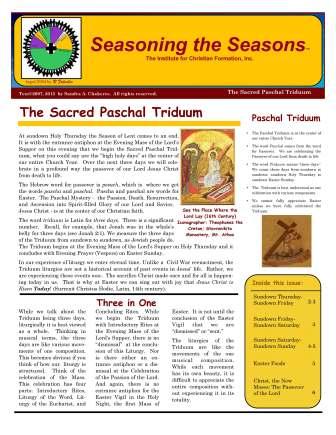The Institute for Christian Formation
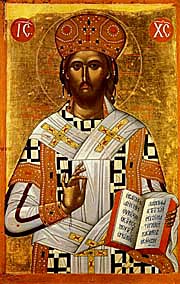
The Sacred Paschal Triduum
Sundown Holy Thursday-Sundown Easter Sunday
Follow us on Facebook to keep up to date with our news and newest resources!
Before Evening Prayer on Holy Thursday, the Season of Lent comes to an end. It is with the entrance antiphon at the Evening Mass of the Lord’s Supper on this evening that we begin the Sacred Paschal Triduum, what you could say are the “high holy days” at the center of our entire Church Year. Over the next three days we will celebrate in a profound way the passover of our Lord Jesus Christ from death to life.
The Hebrew word for passover is pesach, which is where we get the words pascha and paschal. Pascha and paschal are words for Easter. The Paschal Mystery -the Passion, Death, Resurrection, and Ascension into Spirit-filled Glory of our Lord and Savior, Jesus Christ - is at the center of our Christian faith.
See the Place Where the Lord Lay
(16th Century); Iconographer:
Theophanes the Cretan;
Stavronikita Monastery, Mt. Athos
For much more detailed information about the Sacred Paschal Triduum and the Triduum liturgies, refer to our ICF 6-page bulletin on "The Sacred Paschal Triduum", which you can download from this page.
Liturgical resources for the Triduum, from the USCCB (United States Conference of Catholic Bishops) Secretariat of Divine Worship, can be accessed here.
Take an empty holy water bottle, or another clean container, with you to the Easter Vigil so you can bring some of the newly blessed Easter Water home after the Vigil to use in your prayer during the Easter Season.
The word triduum is Latin for three days. Three is a significant number. Recall, for example, that Jonah was in the whale’s belly for three days (see Jonah 2:1). We measure the three days of the Triduum from sundown to sundown, as the Jewish people do. The Triduum begins at the Evening Mass of the Lord’s Supper on Holy Thursday and it concludes with Evening Prayer (Vespers) on Easter Sunday.
In our experience of liturgy we enter eternal time. Unlike a Civil War reenactment, the Triduum liturgies are not a historical account of past events in Jesus’ life. Rather, we are experiencing these events now. The sacrifice Christ made once and for all is happening today in us. That is why at Easter we can sing out with joy that Jesus Christ is Risen Today! (Surrexit Christus Hodie, Latin, 14th century).
Mystical Supper (14th Century)
Vatopedi Monastery, Mt. Athos
antiphon for the Easter Vigil in the Holy Night, the first Mass of Easter. It is not until the conclusion of the Easter Vigil that we are “dismissed” or “sent.”
The liturgies of the Triduum are like the movements of the one musical composition. While each movement has its own beauty, it is difficult to appreciate the entire composition without experiencing it in its totality.
The first movement is sundown Thursday to sundown Friday, the first of the three days. In measuring time in this manner, we realize something interesting. The Mass of the Lord’s Supper on Thursday evening and the Celebration of the Passion of the Lord on Friday afternoon are part of the same “day,” the same movement in our musical composition.

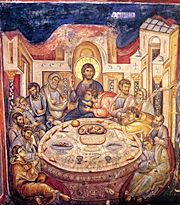
While we talk about the Triduum being three days, liturgically it is best viewed as a whole. Thinking in musical terms, the three days are like various movements of one composition. This becomes obvious if you think of how our liturgy is structured. Think of the celebration of the Mass. This celebration has four parts: Introductory Rites, Liturgy of the Word, Liturgy of the Eucharist, and Concluding Rites. While we begin the Triduum with Introductory Rites at the Evening Mass of the Lord’s Supper, there is no “dismissal” at the conclusion of this Liturgy. Nor is there either an entrance antiphon or a dismissal at the Celebration of the Passion of the Lord. And again, there is no entrance
silence, and approach the altar where an act of reverence is performed, usually a full prostration. There is then a prayer, and we immediately begin with the Liturgy of the Word. The second part of the Celebration of the Lord’s Passion is the Adoration of the Holy Cross. The third part of this Liturgy is Holy Communion. This is not a Eucharistic celebration. We commune from the Blessed Sacrament which was reserved at the Mass of the Lord’s Supper. Following a prayer over the people, all depart in silence.
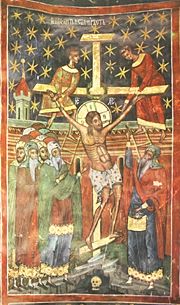
Nailing to the Cross
15th Century
Dragomirna Monastery
Roumania
This can be very helpful in understanding the gift of himself Jesus gives us in the Eucharist. We talk of the Eucharist being a meal, and we talk of the Eucharist being a sacrifice. When we look at the flow of this first “day” of the Triduum, we see clearly this unity of meal and sacrifice. This last supper which Jesus shares with his disciples anticipates his upcoming death. And Jesus’ death gives profound meaning to this meal. As Jesus’ body is broken and his blood is poured forth for us, a new and everlasting covenant is established.
The second major liturgy of this first “movement” or “day” of the Triduum is the Celebration of the Passion of the Lord on Good Friday. This liturgy most appropriately takes place in the afternoon at about 3:00 p.m. The sanctuary is “stark.” The altar was previously stripped. There are no “Introductory Rites” for this Liturgy. The priest (and deacon) enter in
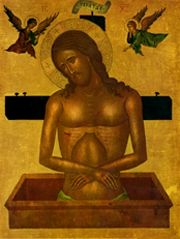
Extreme Humility
16th Century; Russian
The second full day of the Triduum, sundown Friday to sundown Saturday, Christ is in the tomb. Christ has died, but has not yet risen. There are no major liturgical celebrations during this time. We keep the Paschal Fast. We fast from food and from the noise and business of everyday life. In our prayer and in our daily lives we are very attuned to the stone-cold silence of the tomb.
The third “day” of the Triduum, the third and final movement, if you will, of our “musical composition,” goes from sundown Saturday to sundown Sunday. It is important to keep in mind how we are reckoning time - we are counting these days from sundown to sundown. Therefore, the Easter Vigil - the pinnacle of
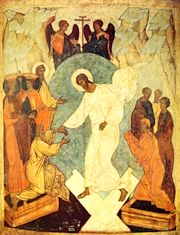
Resurrection
16th Century; Russian
not only the Triduum but the entire Church Year - is the first Mass of Easter Sunday. The Easter Vigil must take place entirely at night. Directives are sent to every parish each year noting the earliest time which the Vigil may begin, determined by the time of sunset on the date in question. The Vigil must conclude before sunrise Sunday morning. The Easter Vigil, what Saint Augustine called “the mother of all holy vigils”, is the highpoint of the entire Church year.
Just as is the case with the Easter Vigil, Mass during the day on Easter Sunday is a triduum liturgy on Sunday of the Resurrection. The Paschal Triduum concludes with Evening Prayer (Vespers) on this Sunday of the Resurrection. Our three day celebration of the Sacred Paschal Triduum leads us to the beginning of fifty days of Easter rejoicing!
Click on image above to download our ICF bulletin, "The Sacred Paschal Triduum."
